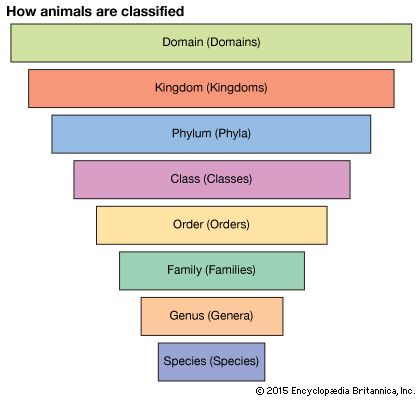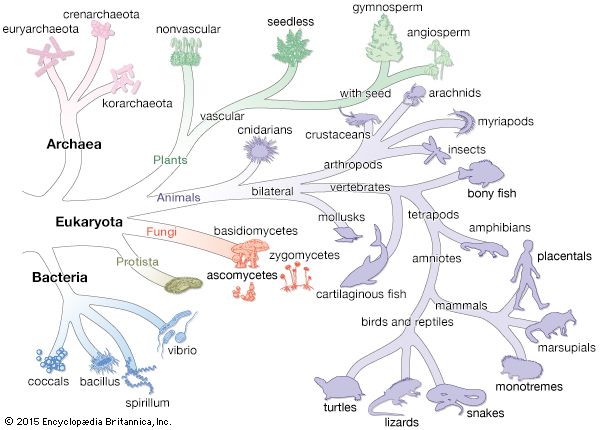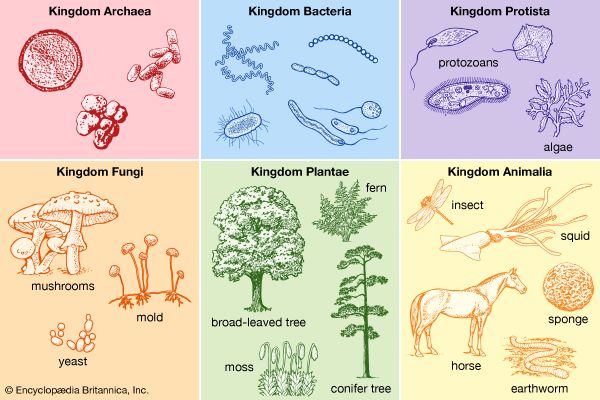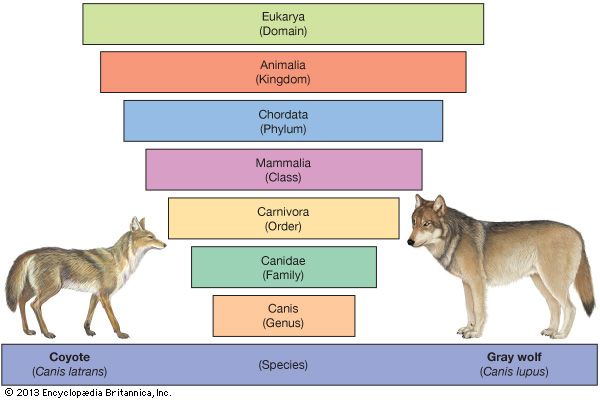
 Biological classification is a system used by scientists to describe organisms, or living things. It is also known as scientific classification or taxonomy. To classify things means to place them in different categories, or groups. Scientists place living things in groups based on the features that the living things share.
Biological classification is a system used by scientists to describe organisms, or living things. It is also known as scientific classification or taxonomy. To classify things means to place them in different categories, or groups. Scientists place living things in groups based on the features that the living things share.
There are several levels of groups in the classification system. The highest-level groups are the largest and the most general. They contain a wide variety of living things. Those large groups are divided into smaller groups of similar organisms. The smaller groups are then split into even smaller groups, which contain organisms with even more similar features, and so on.
Genera, or genuses, are the next-to-lowest groups in the classification system. They contain organisms that are very closely related. The lowest-level groups are the species. Members of a species have many common traits, and they can produce offspring of the same species. Species are sometimes divided into smaller groups such as breeds of dogs.
Domains
 The domains make up the highest level of groups. There are three domains.
The domains make up the highest level of groups. There are three domains.
The first domain is Archaea. These are single-celled organisms. They were once grouped with bacteria. But archaea are different from true bacteria. They evolved separately, and they have different chemistry and structures. Many archaea live in extreme environments, such as very hot areas or soils with high levels of acid.
The second domain is Bacteria, made up of the true bacteria. Bacteria live in almost every environment. Some bacteria can cause diseases in plants and animals. Others play an important role in many ecosystems.
The third domain is called Eukarya. These are all organisms that have a nucleus in their cells. (The single cells of archaea and bacteria do not have a nucleus.) Members of this domain, called eukaryotes, are divided into four kingdoms: Protista, Fungi, Plantae, and Animalia.
The Six-Kingdom System
 Scientists have been classifying living things for hundreds of years. Over time, the classification system has changed. For many years, five kingdoms made up the highest-level groups of organisms. Today, scientists think there are six kingdoms under the three domains.
Scientists have been classifying living things for hundreds of years. Over time, the classification system has changed. For many years, five kingdoms made up the highest-level groups of organisms. Today, scientists think there are six kingdoms under the three domains.
The first kingdom is Archaea. This kingdom is the only one in the Archaea domain.
The second kingdom is Bacteria. . Like Archaea, Bacteria is the only kingdom in the Bacteria domain.
The other four kingdoms are all part of the Eukarya domain. The third kingdom is called Protista. Most protists are single cells. Algae and protozoans are protists.
The fourth kingdom is Fungi. Most fungi have many cells arranged in threadlike groups. Mushrooms, yeasts, and molds are fungi.
The fifth kingdom is Plantae. Plants are also made of many cells. Most plants are green or have parts that are green.
The sixth and largest kingdom is Animalia. Like fungi and plants, animals have many cells. Unlike other living things, animals move around easily and quickly react to their surroundings.
 Below the kingdoms are several other levels. In order, they are phylum, class, order, family, genus, and species. Biological classification lets scientists give an exact name to every species. The scientific name of an organism is made up of two Latin words. The first word is the name of the genus to which the species belongs. The second word is the species name. For example, coyotes and gray wolves are different species, but they belong to the same genus—Canis. The coyote’s scientific name is Canis latrans. The gray wolf’s scientific name is Canis lupus.
Below the kingdoms are several other levels. In order, they are phylum, class, order, family, genus, and species. Biological classification lets scientists give an exact name to every species. The scientific name of an organism is made up of two Latin words. The first word is the name of the genus to which the species belongs. The second word is the species name. For example, coyotes and gray wolves are different species, but they belong to the same genus—Canis. The coyote’s scientific name is Canis latrans. The gray wolf’s scientific name is Canis lupus.




